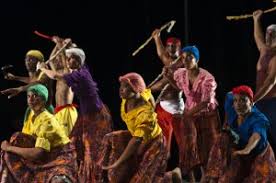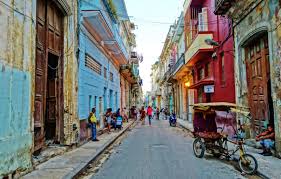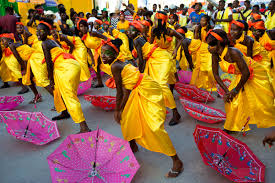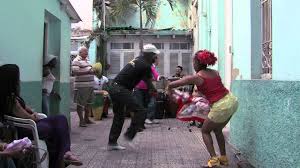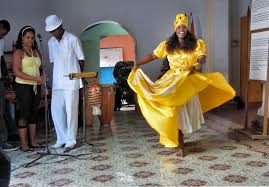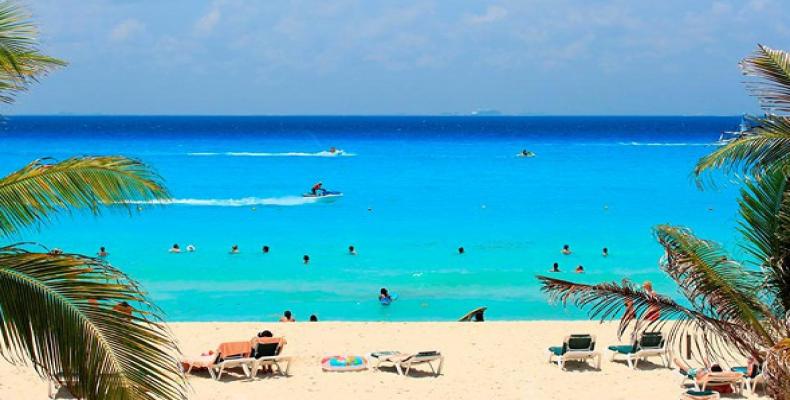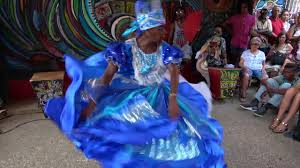 CUBA: LA RUMBA Y SU LENTO PROCESO DE GESTACION.
CUBA: LA RUMBA Y SU LENTO PROCESO DE GESTACION.
La Rumba nació al margen de la sociedad cubana, en barrios pobres con una población predominantemente negra y mulata. Esta música sincrética, resultante de la mezcla de influencias africanas y europeas, ha mantenido durante mucho tiempo la imagen de una subcultura practicada por poblaciones desfavorecidas y potencialmente peligrosas. Como corolario, estuvo sometida a una forma de desprecio y al rechazo de la sociedad dominante.
Los antecedentes de la Rumba se pueden identificar en algunas prácticas folklóricas de las poblaciones pobres, principalmente negras, del occidente cubano, tanto en zonas urbanas como en rurales.
UNA MUSICA INVENTADA POR EL PUEBLO.
Hacia mediados del siglo XIX, la inmensa mayoría de la población esclava negra del país vivía en plantaciones y, por lo tanto, en las zonas rurales. En estos lugares se agrupaban las manifestaciones más fuertes de la cultura africana. Algunos de ellas, como la Yuka, la Makuta, danzas provenientes de las culturas bantúes del Congo y Angola, pueden ser consideradas como antecedentes directas de la Rumba. Leonardo Acosta [Acosta, 1983] menciona, por ejemplo, la existencia de formas rurales de proto-Rumba – incluyendo el baile de la Yuka, bailado en ese momento en los barracones y en las plantaciones de caña de azúcar.
El nacimiento de la rumba, ofrecen interesantes retrospectivas históricas y sus antecedentes no son exclusivos de Cuba. Alejo Carpentier, por ejemplo, menciona la existencia de protorumbas en Santo Domingo y Puerto Rico antes de su aparición “oficial” en Cuba a final del siglo XIX.
Esteban, héroe del reconocido libro Biografía de un cimarrón [Barnet, 1966], describe vívidamente esos bailes de la yuka, practicados al son de tres tambores, al que él mismo participó. También nos ofrece un testimonio directo sobre la primera transición que se produjo después del fin de la esclavitud, cuando los negros, ahora libres, iban a bailar todas las noches en las tabernas, al son de las canciones denominadas “Rumbas” y de las tumbadoras. Esos lugares no estaban muy lejos de aquellos donde los blancos pobres del barrio se reunían para bailar, lo que permitió a diferentes poblaciones descubrir recíprocamente sus respectivos folklores, abriendo así el camino a un proceso de transculturación.
ORIGENES URBANOS, LOS DESFILES CALLEJEROS.
También hay antecedentes de la Rumba en el folklor urbano. Entre los más antiguos, figuran los bailes de negros curros, negros libres de La Habana temidos por su comportamiento fanfarrón y macho; y, luego, a partir de 1830, los bailes de los Ñáñigos o miembros de la secta Abakuá, mezcla de movimiento religioso y de fraternidad de ayuda mutua.
Entonces, este folklor inspiró al teatro bufo con sus canciones, las guarachas, caricaturizando a los negros.
La segunda mitad del siglo XIX también mostró la floración de los Coros de Clave. Inspirados en grupos vocales catalanes, estos coros callejeros ya cantaban, acompañados de instrumentos de percusión, sobre ritmos muy cercanos a los de la Rumba de hoy. Más tarde se dieron a conocer los Coros de Guaguancó, ellos mismos antecesores de los grupos de Rumba. Entre los Coros de Clave más activo hacia el final del siglo XIX se puede citar: El Ronco, El Paso Franco, Los Dichosos en La Habana y, El Bando Azul, El Bando Verde, El Bando Rosado, El Liro
Blanco en Matanzas.
Por último, en las ciudades cubanas existe un antigua tradición de festivales y desfiles callejeros, en gran parte ligado a las tradiciones de los pueblos africanos, el Carnaval, la Fiesta del Día de Reyes con sus desfiles de cabildos, los paseos, los toques de tambores, las congas del Oriente, las canciones de panaderos y otros oficios artesanales….
EL CARNAVAL, DESFILE DE CABILDOS.
Al igual que las Tumbas Francesas del Oriente, los cabildos no son solo formas de expresión cultural, sino también sociedades de ayuda mutua que reúnen poblaciones de la misma estirpe étnica africana o (con mayor frecuencia en medida que se generalizan las mezclas étnicas) de un mismo barrio.
Pero es en los barrios negros del occidente que aparecio a fines del siglo XIX una nueva forma de expresión cubana que pronto tomará el nombre de Rumba. Y es precisamente en estos barrios marginales que se producirán entre esta población pobre de diversos orígenes (en su mayoría negros, pero también blancos y mulatos) un proceso de transculturación dando lugar a nuevas formas de expresión musical, como la Rumba.
Ciertos barrios de Matanzas, como las Alturas de Simpson, la Marina, Versalles… jugaron un papel central en este proceso. En este gran puerto de exportación de la caña de azúcar cultivada en la región, los negros eran particularmente numerosos en los barrios del puerto y los otros barrios pobres de la ciudad.
Ellos vivían allí en solares, cuchitriles superpoblados constituidos por una fila de edificios ligeros y pequeños, sin confort, agrupados en torno a un pasillo central que a veces se extiende a una pequeña plaza, y donde la vivienda de una familia a menudo se reduce a una sola habitación. Esos lugares estaban, por cierto, socavados por todo tipo de patologías sociales como la violencia, el alcoholismo, la miseria, la prostitución, la pequeña delincuencia…
Pero estas poblaciones en gran medida analfabetas también eran artísticamente muy creativas. Para olvidar una vida de privaciones e inseguridad, bailaban y tocaban música en el patio del solar o en la calle. Durante estas celebraciones, se mezclaban las poblaciones de diferentes orígenes – porque aun cuando la mayoría eran negros, los mulatos y blancos (a menudo artesanos pobres), también estuvieron presentes en estos barrios.
 CUBA: LA RUMBA AND ITS SLOW GESTATION PROCESS.
CUBA: LA RUMBA AND ITS SLOW GESTATION PROCESS.
La Rumba was born on the fringes of Cuban society, in poor neighborhoods with a predominantly black and mulatto population. This syncretic music, resulting from the mixture of African and European influences, has long maintained the image of a subculture practiced by disadvantaged and potentially dangerous populations. As a corollary, it was subjected to a form of contempt and rejection by the dominant society.
The antecedents of the Rumba can be identified in some folkloric practices of the poor populations, mainly black, of western Cuba, both in urban and rural areas.
A MUSIC INVENTED BY THE PEOPLE.
By the mid-19th century, the vast majority of the country’s black slave population lived on plantations, and thus in rural areas. In these places, the strongest manifestations of African culture were grouped. Some of them, such as the Yuka, the Makuta, dances from the Bantu cultures of the Congo and Angola, can be considered as direct antecedents of the Rumba. Leonardo Acosta [Acosta, 1983] mentions, for example, the existence of rural forms of proto-Rumba – including the Yuka dance, danced at that time in barracks, and on sugar cane plantations.
The birth of the rumba, offer interesting historical retrospectives and their antecedents are not exclusive to Cuba. Alejo Carpentier, for example, mentions the existence of protorumbas in Santo Domingo and Puerto Rico before their “official” appearance in Cuba at the end of the 19th century.
Esteban, the hero of the renowned book Biography of a maroon [Barnet, 1966], vividly describes those yuka dances, practiced
to the sound of three drums, to which he himself participated. He also offers us direct testimony about the first transition that took place.
Produced after the end of slavery, when blacks, now free, went dancing every night in taverns, to the sound of songs called “Rumbas” and of the tumbadoras. These places were not far from where the poor whites of the neighborhood They met to dance, which allowed different populations to reciprocally discover their respective folklores, thus opening the way to a process of transculturation.
URBAN ORIGINS, THE STREET PARADES.
There is also a history of the Rumba in urban folklore. Among the oldest are the dances of black curros, free Negroes from Havana feared for their boastful and macho behavior; and then, from 1830 on, the dances of the Ñáñigos or members of the Abakuá sect, a mixture of a religious movement and a mutual aid fraternity.
So, this folklore inspired the bufo theater with its songs, the guarachas, caricaturing black people.
The second half of the 19th century also saw the flowering of the Clave Choirs. Inspired by Catalan vocal groups, these street choirs were already singing, accompanied by percussion instruments, over rhythms very close to those of today’s Rumba. Later, the Guaguancó Choirs, themselves ancestors of the Rumba groups, made themselves known. Among the most active Clave Choirs towards the end of the 19th century, we can mention El Ronco, El Paso Franco, Los Dichosos in Havana, and El Bando Azul, El Bando Verde, El Bando Rosado, El Liro.
White in Matanzas.
Finally, in Cuban cities, there is an old tradition of festivals and street parades, largely linked to the traditions of African peoples, Carnival, the Three Kings Day Festival with its town hall parades, walks, touches of drums, congas from the East, the songs of bakers and other crafts …
THE CARNIVAL, PARADE OF CABILDOS.
Like the French Tombs of the East, cabildos are not only forms of cultural expression, but also mutual aid societies that bring together populations of the same African ethnic stock or (more frequently as ethnic mixtures become general) of the same neighborhood.
But it is in the black neighborhoods of the West that a new form of Cuban expression appeared at the end of the 19th century, which would soon take the name of Rumba. And it is precisely in these marginal neighborhoods that a process of transculturation will take place among this poor population of diverse origins (mostly black, but also white and mulatto), giving rise to new forms of musical expressions, such as the Rumba.
Certain neighborhoods in Matanzas, such as Alturas de Simpson, La Marina, Versalles … played a central role in this process. In this large export port for sugar cane grown in the region, blacks were particularly numerous in the port neighborhoods and the other poor neighborhoods of the city.
They lived there in lots, overcrowded hovels made up of a row of light and small buildings, without comfort, grouped around a central corridor that sometimes extended to a small square, and where the dwelling of a family is often reduced to a single room. Those places were, by the way, undermined by all kinds of social pathologies such as violence, alcoholism, misery, prostitution, petty crime …
But these largely illiterate populations were also artistically highly creative. To forget a life of deprivation and insecurity, they danced and played music in the courtyard of the solar or in the street. During these celebrations, the populations mixed of different origins – because even though the majority were black, mulattoes and whites (often poor artisans), were also present in these neighborhoods.
Agencies/ Rumba,MúsicaAfrocubana/ Fabrice Hatem/ Internet Photos/ YouTube/ Arnoldo Varona/ www.TheCubanHistory.com
THE CUBAN HISTORY, HOLLYWOOD.



 CUBA: LA RUMBA y Su Lento Proceso de Gestación. PHOTOS.
CUBA: LA RUMBA y Su Lento Proceso de Gestación. PHOTOS.